The A-Z of the history and development of all the suburbs within the Town of Victoria Park.
Just like the classic Encyclopaedia Britannica only all about the local history and development of all the suburbs within the Town of Victoria Park.
Bakeries
A list of known Bakeries that have operated in the Town. For more information on the individual bakery, please refer to the bakery's individual entry.
Please note this is not an exhaustive list, and we add more information as it becomes available.
If you know of, and or, have records relating to another bakery that operated in the Town, please get in touch with the Library.
Churches - Our Lady Help of Christians, Roman Catholic Church
Under development
Churches - St Aidan's Anglican Church
Status: Closed
Address: 22-24 Camberwell Street, East Victoria Park

Screenshot taken from RetroMaps (Perth sewerage maps) showing the asbestos church building marked in the corner of 22-24 Camberwell Street, East Victoria Park.
Building Status: Demolished, unknown date
History:
The building was made of asbestos and weatherboard in Beechboro and subsequently moved to East Victoria Park circa 1937. The building was then consecrated as St Aidan's Anglican Church, East Victoria Park.
The building was added to and refurbished with a fresh coat of paint in 1951, but little more is known about the church at this stage.
Top Left and Right: The facade of St Aidan's Anglican Church, circa 1958. Courtesy of the State Library of Western Australia (b4487808_7 and b4487808_9). Bottom Left and Right: Looking down the aisle to the alter inside St Aidan's Anglican Church, and Parishioners mingle and chat upon leaving the morning service at St Aidan's, circa 1958. Courtesy of the State Library of Western Australia (b4487808_17 and b4487808_22).
Churches - St David's Presbyterian Church
Under development
Churches - St Joachim's, Roman Catholic Church
Under development
Churches - St Peter's Anglican Church
Under development
Churches - Victoria Park Methodist Church
Status: Closed
Address:
1st Church - Albany Road, Victoria Park
2nd Church - Corner of Duncan (formerly Cavendish) Street and Shepperton Road, Victoria Park
Building Status:
1st Church - Erected 1896 - Demolished unknown date
2nd Church - Erected 1912 - Demolished 1977
History:
The Methodist Church in Victoria Park
(from “Praise the Lord with Gladness: [The] Story of [the] Methodist Church Victoria Park”)

In 1896 the Rev G. E. Rowe (Chairman of the Perth Methodist Circuit) approved the building of a Church in Victoria Park.
On 18 May 1894 Victoria Park was proclaimed a Road’s Board, and the year after the church was built Victoria Park was gazetted a Municipality (1897).
The Church building erected in Albany Highway (later the site of Hearn’s furniture shop) in 1896, was a galvanised iron structure purchased from Coomb Ward & Co., of Lord Street Perth.
The Church was situated on the northern side of Albany Road facing south.
The building consisted of a white painted corrugated iron structure of two rooms and a small entrance porch which faced east. The main room was the church and a small rectangular room at the rear was used for Sunday school classes, social purposes etc. The interior was lined with varnished light coloured knotty pine. Several large kerosene lamps hung from the ceiling.
When the new Church was built in Cavendish (Duncan) Street in 1912, the old church was used for a time as a furniture factory.

PH00459-04 Victoria Park Methodist Church, erected 1912. This photograph was probably taken soon after 1912 and before Cavendish (now Duncan Street) was sealed. Local History Collection, Town of Victoria Park Library Service.
During 1911 the land on Albany Highway was put up for sale and a block of land was purchased (on what is now the south west corner of Shepparton Road and Duncan Street).
During the ministry of the Rev Frank Close, (who was at Victoria Park from 1911 till 1914), the foundation stone was laid by Charles Harper Esq. on the 12 October 1912. (cost £830).
On 6 September 1918 Cavendish Street was renamed Duncan Street after the Municipality’s first Mayor, Hugh George Duncan.
On 10 September 1921 the foundation stone for the new hall was laid by Mr F.S.N. Mortlock, and Mr H.E. Mofflyn. Cost of the new hall was £185. The building of the Manse (1923) in Shepperton Road on land donated for that purpose by Mr Mortlock, cost £750.

PH00459-01 Victoria Park Methodist Church, cnr Duncan St and Shepperton Rd Local History Collection, Town of Victoria Park Library Service.

PH00459-02 Victoria Park Methodist Church, cnr Duncan St and Shepperton Rd Local History Collection, Town of Victoria Park Library Service.

PH00459-03 Victoria Park Methodist Church and Hall, cnr Duncan St and Shepperton Rd Local History Collection, Town of Victoria Park Library Service.
The Duncan Street Church was demolished in 1977 due to the widening of Shepperton Road, and a shopping mall was built on this corner.
A new Church was built at 49 Swansea Street to cater for the congregations of Bentley, Carlisle, Duncan Street and St David’s.

List of Ministers of the Victoria Park Methodist Church through the years. Local History Collection, Town of Victoria Park Library Service.
National Service
[This article was originally shared as a post to the Town of Victoria Park Library’s Facebook page on 5 December 2022 to mark 50 years since the end of National Service. It was titled: National Service - Victoria Park Remembers]
Victoria Park Remembers #OnThisDay, 50 years ago – 5 December 1972 – Newly elected Prime Minister Gough Whitlam abolished conscription. Many may not realise that Australia has had a few variations of conscription (also known as National Service) at different times, dating right back to when we first became a nation. But it was Australia’s instigation of conscription to support its involvement in the Vietnam War, that is perhaps the most controversial.
During Australia’s involvement in the Vietnam War (13 July 1962-11 January 1973) the government decided it required more personnel to support the regular military forces. The National Service Act 1964 was passed on 10 November 1964 and would be in operation for just over eight years (with amendments). This Act introduced compulsory National Service (conscription), which allowed for 20-year-old males to be selected for service via a ‘sortition’ or lottery draw. This selection by lottery was based on date of birth. Originally conscripts were required to serve two years full-time continuous service, and subsequently three years as an active reservist. At first conscripts only served on Australian shores but by March 1966 the Act had been amended several times and the government announced it would send National Servicemen to South Vietnam.
In the eight years of conscription for the Vietnam War, a little over 6,400 Western Australian men were called up to serve their country. The total number called up from suburbs within the Town of Victoria Park was 250. Of the little over 6,400 West Australians, 47 died whilst in the service of their country, and nine of these were from Victoria Park.
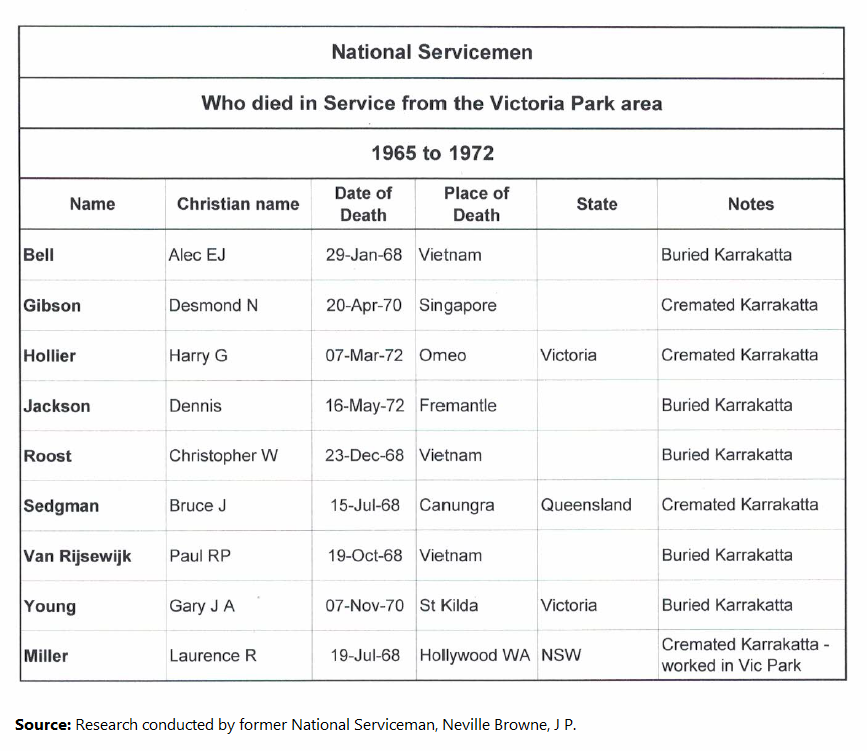
Table showing National Servicemen who died in service from the Victoria Park area, 1965-1972.
Courtesy of Neville Browne, JP.
There is however another little known and extremely sad fact about these statistics… the National Servicemen who died in service overseas have their names listed on the Roll of Honour and are commemorated as is only fitting and right. However, for those National Servicemen who died whilst in service, BUT in Australia, there is no commemoration. This means that five of the nine of our own men from Victoria Park who died whilst serving their country, do not have their names listed on the Honour Roll in Canberra or officially commemorated on any other honour roll. This is an injustice as these men, and many others for whom the same has occurred, were training under hazardous conditions and very sad accidents occurred. Some men became ill and died from their illnesses. However, be it accident or illness, all these men died whilst serving their country, the only thing they didn’t do was die overseas. Their deaths were just as gallant as they were preparing and learning military craft as thousands of their ancestors had done before, but all whilst being called up. They had little choice but to accept the call to National Service when their birthday came up in the lottery. They didn’t choose to die, as few do, but they did and their lack of acknowledgement in official realms is extraordinarily sad.
Lieutenant-Colonel (retired) Neil Smith, AM, described the story of the unsung heroes of National Service in an ANZAC Day address to ABC Victoria on 25 April 2011, which is quoted in full here following:
“CONSCRIPTION’S UNSUNG HEROES 1951-1973 by Neil Smith
“About Neil Smith – Lieutenant-Colonel Neil Smith, AM, spent 24 years in Army Service, including active service with the infantry in Vietnam as a young infantry officer and service as an ammunition technical officer. He now specialises in genealogical and service aspects of former Australian and British Defence personnel through his research service, Mostly Unsung, a MHHV member.
“For over a century National Service, or Conscription, has often been part of the Australian Army mix… In fact since World War Two, almost 300,000 young Australian Nashos have fulfilled an obligation to serve our country, in both peace and war.
“The sacrifice of many has been ignored.
“In both world wars the initial fighting force sent overseas consisted of volunteers, not Conscripts. Gisborne newsagent Jim Sumner, who was killed in action at Pozieres in 1916, was just such a volunteer. He was not compelled to enlist. He chose to join up. Other volunteers died at home in Australia. Patrick Cooney, a Light Horseman from Richmond succumbed to pneumonia in a base hospital in Fremantle. Like Jim Sumner, his supreme sacrifice is recorded on the Australian War Memorial, and other official honour rolls of the fallen.
“Although there was a form of conscription used during World War Two, it was only the early volunteers, like Cohuna resident Bill McGlone, who could be sent overseas to fight. McGlone died beside his anti tank gun, trying to stem the Japanese advance down the Malayan Peninsula in January 1942. Fred Smith left a successful farm life behind. He didn’t have to, but he offered his services to fight in early 1941. Fred died in an aircraft training accident in Western Australia before he could see any action. Like all the servicemen and women who died in World War Two, Pilot Officer Smith’s name is among those on the Australian Roll of Honour and Commonwealth War Graves listings.
“Sixty years ago, in 1951, a new Conscription scheme was introduced for all 18 year old men. This scheme of Compulsory Military Service, provided for enlistment in the Navy and the Air Force, as well as the Army. Men like George Hellyer, from Oakleigh, received their Call-Up Notice in the mail. Then followed recruit training at Army camps such as Puckapunyal. After three months the newly trained Conscripts were released, to undertake several years Part Time or Reserve service. Although they had been forced to enlist, these men were not sent to any war zones. Roger Wood from Box Hill was a young soldier from this conscription era. After basic training he commences his Part Time commitment with the Melbourne based 2nd Commando Company. He lost his life in Port Phillip Bay, during a hazardous, Army watercraft training exercise.
“By the time the Scheme finished in 1959, over 50 young men, like Roger Wood, had died whilst serving in Australia. Their names are not to be found on any official rolls of honour.
“In the 1960’s another, more contentious National Service scheme was introduced. From 1965 some young men, like Bruce Sedgman, were selected on the basis of a ballot. Those selected were obligated to serve up to two years in the Regular Army.

Private Bruce Sedgman in his uniform, April 1968.
Courtesy of Neville Browne, JP
“For the first time, Australian Conscripts were compelled to swell the Regular Army ranks of volunteers on Active Service, and thousands were deployed to Malaysia and South Vietnam. Battle casualties among the Conscripts soon followed. Arch Williams was killed instantly by a sniper in Bien Hoa Province, South Vietnam.
“Newly married Mildura man Ramon Deed, was another. He died of wounds after an anti-personnel mine was accidentally triggered in 1967. Arch and Ramon are among the 212 Conscripts or, Nasho’s as they are often called, who died on Active Service in South East Asia. Their names are recorded on the nation’s honour boards at the Australian War Memorial, and elsewhere.
“On the other hand, consider David Andrews from Ascot Vale, He was drowned in Queensland’s Coomera River, whilst undertaking rugged battle training at Canungra’s Jungle Training Centre, only weeks before being sent to South Vietnam.
“Think also of PMG technician, Signaller David Brett from Wangaratta who succumbed to a sudden illness at Heidelberg in January 1968.
“Even though more post World War Two Nashos, like David Andrews and David Brett, died in Australia, than on Active Service, their names are not listed on the nation’s honour rolls. Many saw the National Service scheme of the 60’s and 70’s as unfair.
“This was because only some young men, of age 20 were selected by ballot to serve.
“Bruce Sedgman [from Victoria Park, WA] for example was the only man known to have been selected from his football team. With a promising legal career in the Crown Law Department put on hold. Bruce left his family behind in 1967, and was sent to Puckapunyal to learn the basics of soldiering. After recruit camp Private Sedgman satisfactorily completed Infantry training. Next he was transferred to the 1st Division in Brisbane as a Rifleman. Bruce died, near Canungra, in a vehicle accident on 15 July 1968.

Bruce Sedgman and his football teammates, 1961.
Courtesy of Neville Browne, JP.
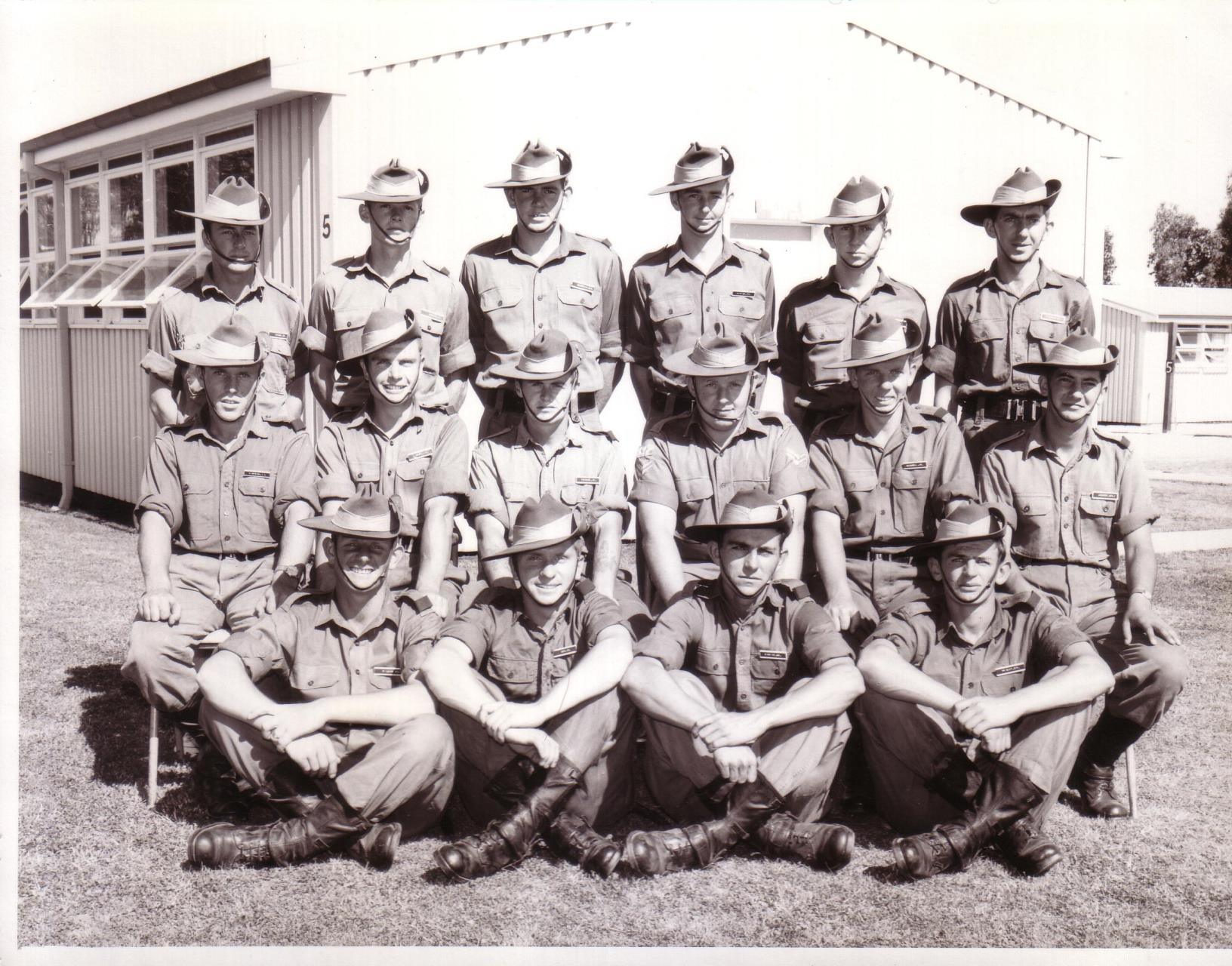
Private Bruice Sedgman (third from left, back row) and his National Service mates, unknown location and date.
Courtesy of Neville Browne, JP.
“No official recognition of Bruce Sedgman’s service and sacrifice is known to exist. Apart from the initial Defence telegram and condolences, his family to this day have received little information on his fate or indeed his service.

Notification of Bruce Sedgman's death from the funeral directors.
Courtesy of Neville Browne, JP.
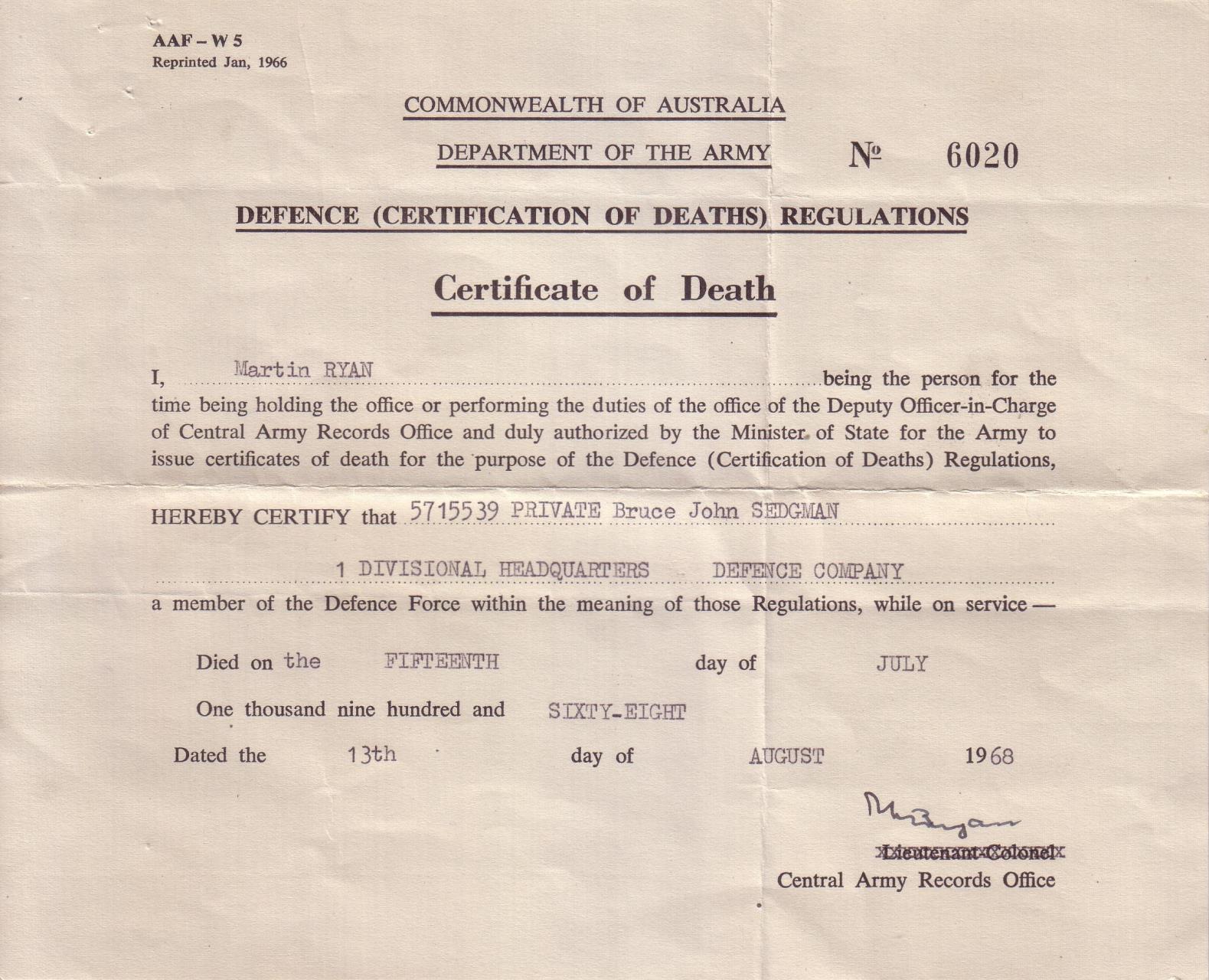
Private Bruce Sedgman's death certificate.
Courtesy of Neville Browne, JP.
“Hundreds of young National Servicemen in the 1960’s and 70’s died whilst serving in a wide range of circumstances. Motor vehicle and training accidents were common. Many lives were lost to various types of sickness.
“Former Brunswick clerk Frank Chiappazzo died when the bridge construction task he was employed on, collapsed and caved-in, at the Army Engineering School near Sydney.
“Even though they were not on Active Service, some National Servicemen died overseas as well as throughout Australia.
“Dick Simpson, a farm hand from Carlton, died suddenly from a mysterious illness in Port Moresby. Others died elsewhere in New Guinea and Singapore.
“These men did not die in a war zone. But unlike their forefathers who died in similar circumstances in both World Wars, they are not publicly recognised for their service, nor are they commemorated on any honour rolls.
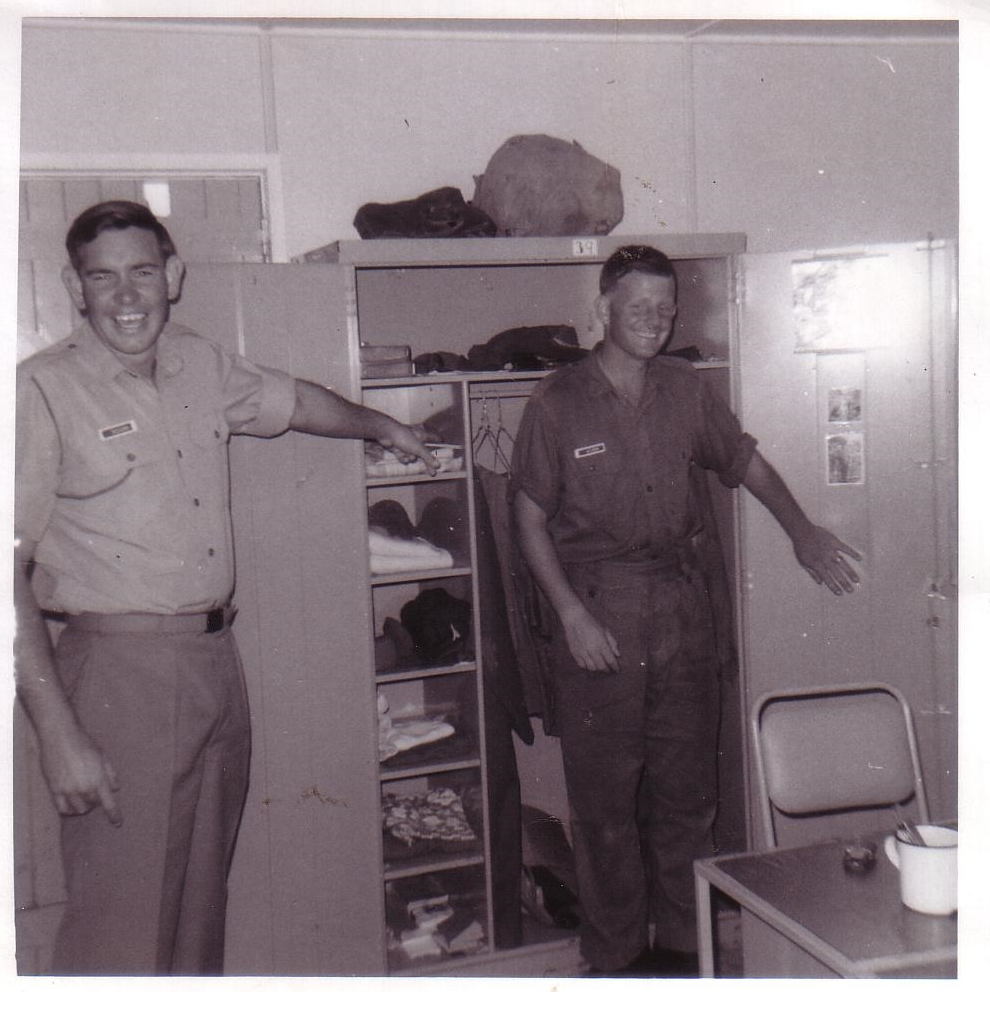
Private Bruce Sedgman larking around with a mate, unknown date.
Courtesy of Neville Browne, JP.
“With increased public resentment towards National Service, and growing battle casualties in South East Asia, the scheme was finally scrapped in 1972.
“Too late though for David Belyea from Camperdown, who was fatally injured by an Army forklift truck near Brisbane.
“Even now, there is still little applause for those who answered the call as Conscripts after World War Two, and especially those who died while serving.

Private Bruce Sedgman, unknown date, resting against a tree during training.
Courtesy of Neville Browne, JP
“With the news of losses among Australia’s Defence Forces both at home and overseas in Afghanistan and elsewhere increasingly commonplace, it is timely to remember those who fell in yesteryear. With such little attention paid to our fallen National Servicemen, we should pause to remember the 500 of their number who gave their lives whilst serving Australia.
“We should remember in particular, those Nashos who died serving, far from any battlefield, but who might otherwise, be forgotten.” (Smith, Neil 2011, Conscription’s Unsung Heroes 1951-1973, ABC TV Victoria, ANZAC Day 25 April 2011)

'Tragedy', newspaper report on the death of Private Bruce Sedgman. Unknown newspaper and date.
Courtesy of Neville Browne, JP.
The images shown with this post show some of the faces of the nine men who died in service for Australia. Also included is a table listing those National Servicemen from the Victoria Park area who died in service from 1965 to 1972. This table includes the names of the five men who died in service in Australia. With kind acknowledgment to Neville Browne, JP for his research and for sharing it with us.
Victoria Park Remembers all National Servicemen who have served our country. We especially remember on this day however, the nine National Servicemen from the Victoria Park area who made the supreme sacrifice of their lives in service to their beloved Australia, both overseas and at home during the period 1965 to 1972:
Alec Ernest James BELL
Desmond N GIBSON
Harry G HOLLIER
Dennis JACKSON
Laurence R MILLER
Christopher W ROOST
Bruce John SEDGMAN
Paul Richard Peter VAN RIJSEWIJK
Gary J A YOUNG
|
Private Alec Ernest James BELL
Date of Death: 29 January 1968, Vietnam
(Image courtesy of Janet McWhirter)
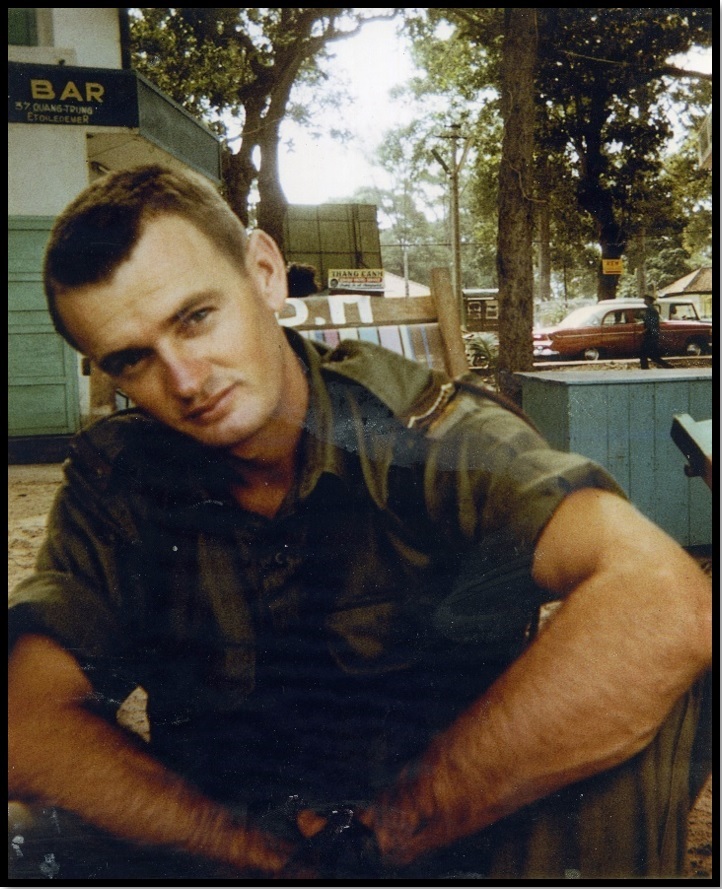 |
Lance Corporal Paul Richard Peter VAN RIJSEWIJK
Date of Death: 19 October 1968, Vietnam
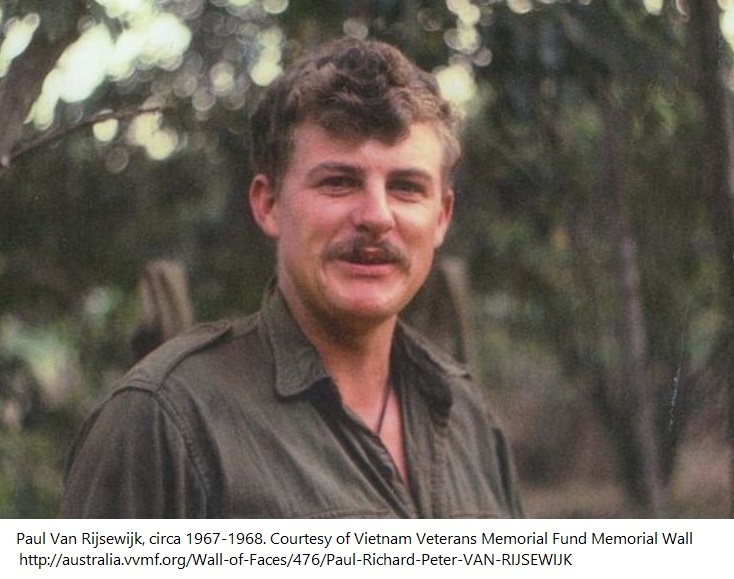 |
Date of Death: 23 December 1968, Vietnam |
Are you a relative or friend of one of the nine brave men listed above? We would love to be able to record more of their stories in our Local History Collection here at the Victoria Park Library, so please get in touch – vicparklibrary@vicpark.wa.gov.au.
Download a print copy of this article: National Service - Victoria Park Remembers
Oral History Interviews
The Library collects and commissions oral history interviews with people who are living or have lived/worked within the Town of Victoria Park. The interviews cover many topics including family life, growing up, school days, local businesses, local organisations such as churches, the war years, transport, occupations, romance, and much more. To discover a little piece of our history in the voice of those who have lived it, check out Victoria Park Voices - available via the library catalogue and our website
Park names (meaning of)
Refer to Nomenclature Victoria Park.
Street names (meaning of)
Refer to Nomenclature Victoria Park.
Terminus Bakery
A.B. Walkemeyer bought the property at 916 Albany Road in 1924 and established the Terminus Bakery. A.B. Walkemeyer died in 1934 and the Terminus Bakery was taken over by his son Bernie who was joined by his son Otto in 1949.
The Terminus Bakery continued to trade at 916 Albany Highway until sold on the 4 January 1962 to Brennan's Bakery. It was sold, because like other small bakeries it was no longer financially viable as larger companies entered the market.
In July 1964 the premises that were then being used as a storage facility were gutted by fire. Very little remained of the old Terminus Bakery.
N.B. At sometime between 1930 and 1937 street numbers were adjusted for some unknown reason. The Terminus Bakery was at 916 (formerly 996) Albany Highway for its entire operations. The site today (November 2024) is home to a petrol station and behind a block of flats known as “Lafa Court”.
____________________________________________
Find out more about the Terminus Bakery…
Victoria Park Voices, the Oral History Collection of the Town of Victoria Park Library holds interviews with two of A.B. Walkemeyer’s grandsons, Otto and Leon Walkemeyer. Refer to the Library Catalogue or our Oral History page for how to access these interviews.
Picture Victoria Park, the Photographic Collection of the Town of Victoria Park Library also contains photographs of the Terminus Bakery. Please refer to the Library Catalogue for more information.